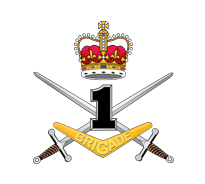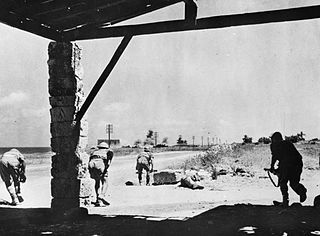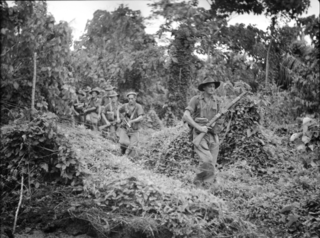
The Second Australian Imperial Force was the volunteer expeditionary force of the Australian Army in the Second World War. It was formed following the declaration of war on Nazi Germany, with an initial strength of one infantry division and related auxiliary components. After considerable expansion of this force, three divisions were sent to the Middle East and North Africa, while the 8th Division was sent to garrison British Malaya and Singapore.

1st Brigade is a combined arms formation of the Australian Army. Formed in 1903 as a militia formation based in New South Wales, it was reconstituted as part of the Australian Imperial Force in 1914 for service during World War I, the brigade fought at Gallipoli and on the Western Front before being disbanded in mid-1919. In 1921, the 1st Brigade was re-raised as a unit of Australia's part-time military forces, based in New South Wales. During World War II the brigade undertook defensive duties before being disbanded. In 1948, it was re-raised as an integral part of the Australian Regular Army. Currently the brigade is based at Robertson Barracks in Darwin and at RAAF Base Edinburgh near Adelaide, South Australia. It is the first of the Australian Army brigades to be re-organised as a combat brigade under Plan Beersheba.

The 3rd Brigade is a combined arms brigade of the Australian Army, principally made up of the 1st and 3rd Battalions of the Royal Australian Regiment. Initially raised in 1903 as part of the post-Federation Australian Army, it was removed from the order of battle in 1906 following the restructure of the field force. It was re-formed in 1914 for service during World War I, taking part in the fighting at Gallipoli and on the Western Front in Europe. During World War II the brigade was used in a defensive role before it was disbanded in 1944. It was re-raised in 1967 for service during the Vietnam War and later went on to provide the nucleus of the deployment to East Timor during the Australian-led intervention in 1999. The brigade is currently based at Lavarack Barracks in Townsville, Queensland.

The 16th Brigade was an infantry brigade in the Australian Army. First raised in 1912 as a Militia formation to provide training under the compulsory training scheme, the brigade was later re-raised as part of the First Australian Imperial Force during World War I. Its existence was short-lived, as it was disbanded after about six months, before it could be committed to the fighting on the Western Front. Raised again in 1939 for service during World War II, the brigade was deployed to the Middle East in early 1940 and subsequently saw action in the Western Desert and in Greece in 1941. In 1942, it returned to Australia in response to Japan's entry into the war, and later the brigade played a prominent role in the Kokoda Track campaign and at Buna–Gona in Papua. Withdrawn to Australia in early 1943, the 16th Brigade was re-organised and received many replacements from disbanding formations, but it was not recommitted to combat operations until late in the war. In 1944–1945, the brigade was committed to the Aitape–Wewak campaign in New Guinea. After the war, the brigade was disbanded in 1946. Today, its name is perpetuated by the 16th Aviation Brigade which was raised on 2 April 2002.

The 17th Brigade was an infantry brigade in the Australian Army. First raised in 1912 as a Militia formation to provide training under the compulsory training scheme, the brigade was later re-raised as part of the First Australian Imperial Force during World War I. Established in 1917 in the United Kingdom, it was broken up and disbanded without seeing action, and its personnel used as reinforcements for other formations. Reformed during World War II, it took part in fighting in Libya, Greece, Crete, Syria in 1941–1942. Following Japan's entry into the war, the Australian government pressed for the 6th Division's return, and the 17th Brigade was subsequently brought back from the Middle East, via Ceylon where they undertook defensive duties until July 1942. Following the brigade's return to Australia, it was deployed to New Guinea for two campaigns: the Salamaua–Lae campaign in 1943 and the Aitape–Wewak campaign in 1944–1945. After the war, the brigade was disbanded in January 1946. Today, its name is perpetuated by the 17th Sustainment Brigade, which was raised as a logistics formation in May 2006.

The 9th Brigade is a Reserve formation of the Australian Army headquartered at Keswick Barracks in Keswick, South Australia, with elements located in New South Wales and South Australia. The brigade was first raised in 1912 in New South Wales following the introduction of the compulsory training scheme.

The 19th Battalion was an infantry battalion of the Australian Army. Although the unit's numerical designation was bestowed upon it during World War I, the unit can trace its origins back to 1860 when a Volunteer Rifle corps was raised in South Sydney. During World War I, the 19th Battalion was raised as a unit of the Australian Imperial Force, attached to the 5th Brigade, of the 2nd Division. The unit was formed in 1915 and was first sent to Gallipoli where it fought against the Turks, before being withdrawn from the peninsula and being sent to France in early 1916, where it served in the trenches along the Western Front. Over the next two years the battalion fought in many major battles and won numerous battle honours. In April 1918, it took part in defending against the German Spring Offensive, before the Allies launched their own last-ditch effort as part of the Hundred Days Offensive. The battalion was disbanded in October 1918 due to manpower shortages in the AIF and most of its men were sent to reinforce the other three battalions of the 5th Brigade.

The Second Army was a field army of the Australian Army, during World War II. Raised in April 1942 from the existing HQ Home Forces, the formation remained in Australia throughout the war and was responsible for commanding forces in the Australian eastern states. Initially, the formation controlled several divisions, including several US formations; however, as the focus of the Allied war effort shifted north the formation was reduced in size over 1943. Throughout 1944 and 1945, the formation's combat forces were greatly reduced and eventually it became a largely training and line of communications headquarters. The war ended in August 1945, and the formation ceased to exist in early 1946.
The 62nd Battalion was an infantry battalion of the Australian Army. It was first raised in 1917 during World War I but was disbanded before seeing active service. During World War II the battalion was re-raised in 1942 as a unit of the Militia and was tasked with undertaking garrison duty in Dutch New Guinea, where they defended Merauke from possible Japanese attack. In 1944, the battalion was disbanded and its personnel distributed to units of the 9th Division as reinforcements.

The 35th Battalion was an infantry battalion of the Australian Army. Originally raised in late 1915 for service during the First World War, the battalion saw service on the Western Front in France and Belgium before being disbanded in 1919. In 1921, it was re-raised in the Newcastle region of New South Wales as a unit of the Citizens Force. It was subsequently amalgamated a number of times during the inter-war years following the Great Depression, firstly with the 33rd Battalion and then the 2nd Battalion, before being re-raised in its own right upon the outbreak of the Second World War. Following this the battalion undertook garrison duties in Australia before being deployed to New Guinea where they took part in the Huon Peninsula campaign. After the end of the war, the 35th Battalion was disbanded in early 1946.
The Newcastle Covering Force was an Australian militia force responsible for protecting the strategically important Newcastle region in New South Wales and its approaches during World War II. Established on 8 April 1941, the formation's composition changed over the course of its existence, starting from a single infantry battalion support by a machine-gun unit and swelling to roughly brigade-size, with a brigade headquarters and three battalions – two infantry and one garrison – supported initially by a machine gun battalion that was later converted to a motor regiment. The unit was responsible for defending the important port and air bases in and around the town, part of Fortress Newcastle, against a feared Japanese invasion. Newcastle Covering Force was converted on 15 April 1942 to the 10th Division, a regular Australian Army unit, following a complete re-organisation of the higher command structures of the Australian Army.

The 2nd Health Brigade (2HB) is an Australian Army brigade. The 2nd Brigade was formed in 1903 as a militia infantry formation based in Victoria, the brigade later served during the First World War as part of the Australian Imperial Force, allocated to the 1st Division. During the war, the 2nd Brigade took part in the fighting at Gallipoli, including the Battle of Krithia where it lost almost a third of its strength. Later they took part in the Battle of Lone Pine before being withdrawn back to Egypt in December 1915. Following this the brigade was transferred to the Western Front in France and Belgium where, between March 1916 and the armistice in November 1918, they took part in most of the major Allied operations.

The 2nd Armoured Brigade was a formation of the Australian Army during World War II. The brigade was formed in July 1941, at Puckapunyal, Victoria, from Second Australian Imperial Force volunteers. It was assigned to the 1st Armoured Division in July 1941, with the intention of deploying it to the Middle East. However, it was reassigned to home defence following Japan's entry into the war, and was then transferred to the 3rd Armoured Division in October 1942. The brigade remained in Australia, undertaking defensive duties in Victoria and Queensland before being disbanded in January 1944. While it did not see any active service as a formation, some of its constituent units eventually took part in the campaigns on Tarakan, Labuan, Bougainville and around Aitape–Wewak in 1944–1945 after transferring to other brigades.

The 14th Brigade was an infantry brigade of the Australian Army. Originally raised in 1912 as a Militia formation, it was later re-raised in 1916 as part of the First Australian Imperial Force for service during World War I, the brigade was assigned to the 5th Division and served on the Western Front between 1916 and 1918 before being disbanded. It was later re-raised as part of the Australia's part-time military forces during the inter-war years. During World War II, the brigade was a Militia formation and it took part briefly in the New Guinea campaign with elements of the brigade undertaking defensive duties around Port Moresby before taking part in the fighting along the Kokoda Track and around the Japanese beachheads at Buna–Gona. The brigade was disbanded in mid-1943 as part of a rationalisation of Australian military forces as a result of manpower shortages.

The 10th Brigade was an infantry brigade of the Australian Army. Originally formed in 1912 as a Militia formation, the brigade was re-raised in 1916 as part of the expansion of the Australian Imperial Force following the end of the Gallipoli campaign. It subsequently saw service on the Western Front in France and Belgium during World War I. After the war it was disbanded but was re-raised in 1921 as a part-time formation based in the state of Victoria. During World War II the brigade was used in a garrison role in Australia before being disbanded in 1942. The brigade is slated to be re-raised as the Army's 'Fires Brigade' to host and operate the Australian Army's High Mobility Rocket System (HIMARS) and National Advanced Surface-to-Air Missile System (NASAMAS)

The 58th Battalion was an infantry battalion of the Australian Army. It was raised in 1916 for overseas service during World War I and saw action on the Western Front from June 1916 until the end of the war. Following the end of hostilities it was disbanded in 1919; however, in 1921 the battalion was re-raised as part of the part-time Citizens Force and remained in existence until 1942 when it was amalgamated with the 59th Battalion to form the 58th/59th Battalion. That battalion subsequently saw active service in the Pacific against the Japanese during World War II before being disbanded in 1946. After the war, the battalion was re-formed as an amalgamated Citizens Military Force unit, the 58th/32nd Battalion, which was based in Melbourne. This unit remained in existence until 1960 when it was subsumed into the Royal Victoria Regiment.

The 32nd Brigade was a formation of the Australian Army during World War II. A militia formation, the brigade was formed at Broadmeadow, New South Wales, in January 1942, as part of the Newcastle Covering Force and then the 10th Division. After carrying out defensive duties on the coast south of Newcastle at the height of invasion fears, as the threat subsided the brigade was disbanded in September 1942 and its constituent units reallocated to other formations or disbanded.
The 31st Brigade was a formation of the Australian Army during World War II. Raised in January 1942, amidst concerns of a Japanese invasion of Australia, the brigade was tasked with defending the eastern New South Wales coast around Botany Bay and Cronulla. Initially consisting of just two infantry battalions, after several months a third battalion was assigned to bring it up to strength. The formation was only short-lived and was disbanded in September 1942, having never seen combat, with its battalions being reassigned to other formations.
The 28th Brigade was a formation of the Australian Army during World War II. Raised in April 1941, the brigade consisted of Militia units who were assigned to carry out defensive duties on the New South Wales Central Coast. After being mobilised for war in December 1941, the brigade mounted defensive duties throughout 1942 and 1943, defending against a possible Japanese invasion. As this threat passed, the brigade's role diminished throughout 1943. Eventually, the brigade was disbanded in December 1943 having never seen combat. Its constituent units either amalgamated with others, or broken up as reinforcements.

The 27th Battalion was an infantry battalion of the Australian Army. It was initially raised in 1915 as part of the all-volunteer First Australian Imperial Force for service during World War I. During the conflict, the battalion saw action briefly at Gallipoli before later fighting on the Western Front between 1916 and 1918. It was disbanded in 1919, but was re-raised in 1921 as part of the Citizens Force, which later became the "Militia". During World War II the battalion was used mainly in a garrison role until the last year of the war when it was committed to the fighting against the Japanese during the Bougainville campaign. Following the end of hostilities it was disbanded in May 1946. Between 1948 and 1965 the battalion was re-raised and disbanded a number of times before eventually becoming part of the Royal South Australia Regiment. It was disbanded for a final time in 1987, when it was amalgamated with the 10th Battalion, Royal South Australia Regiment to form the 10th/27th Battalion, Royal South Australia Regiment.
















